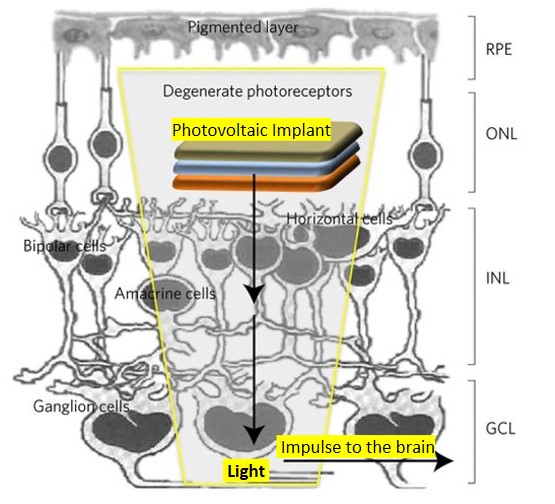By Raisa Rafique
 It was love at first sight for Kristina when she found her current research project at UNSW after multiple lab placement programs. Since then every day for her has been something like a wild quest into unlocking the secrets of the complex world of conductive polymers. Her research as an organic chemist strives to tame these somewhat uncooperative substances into forming therapeutic patches for patients suffering from heart-attacks. When she’s not in the lab pursuing these ‘funky plastics’, Kristina can be found either curled up cosily with a nice little book, having fun with friends, playing trombone in a band or travelling far and wide to her heart’s content.
It was love at first sight for Kristina when she found her current research project at UNSW after multiple lab placement programs. Since then every day for her has been something like a wild quest into unlocking the secrets of the complex world of conductive polymers. Her research as an organic chemist strives to tame these somewhat uncooperative substances into forming therapeutic patches for patients suffering from heart-attacks. When she’s not in the lab pursuing these ‘funky plastics’, Kristina can be found either curled up cosily with a nice little book, having fun with friends, playing trombone in a band or travelling far and wide to her heart’s content.
“I knew from a very young age that I wanted to do research,” Kristina Fidanovski’s eyes glittered fondly as she started telling her story.
Kristina’s journey began in Perth, at the University of Western Australia, where she was trying to figure out which road in science excited her more- physics or chemistry. While she had genuine love and appreciation for both, she became particularly taken with the idea of various medical applications of chemistry while working with antibiotics during her Honours program. Finally, her journey brought her to UNSW where she came across her current PhD project and felt that instant spark, “Yes! This is what I want to do!!”
So what is it about her work that excites her so much? Kristina is working to develop a conductive patch or ‘band-aid’ capable of restoring function to a damaged heart that has suffered a heart-attack. For this, she needs to work with polymers, a kind of multi-unit substance made of millions of repeating core individual units called monomers (plastic, resin etc. are some examples). During a heart-attack, part of the heart muscle dies and that section loses its conductivity and becomes scar tissue, which doesn’t transmit electric signals well. A biologically compatible polymer patch capable of conducting electricity can therefore help the injured heart heal by synchronously transmitting signals throughout the organ.

Currently the non-conductive elements of this patch have been described. The natural polymer mixed with a light sensitive dye can be stuck on to the target tissue with a green light. This is where Kristina’s work comes in, because she has to explore conductive polymers and try to make sure they stay conductive where others would lose their conductivity in the biological environment. A typical day in the lab would find her immersed in cooking up these polymers and characterising their properties for around 4-8 hours with the rest of her time spent at the computer analysing her data or writing. “There are times when I actually find it a bit difficult to stop, because I love my work and it feels too good being in the lab…and then I end up working for 8-12 hours in a day, which I will definitely regret afterwards!” Kristina feels that a good work-life balance is definitely important, and tries to de-stress by doing yoga at a set hour during the evening.
Kristina has experienced some major low points in her journey due to health issues, but she refused to be defeated by her circumstances. Despite suffering from a chronic autoimmune illness, she continues to pursue her career goals like a true fighter, doing what she loves to do every day with renewed vigour and strength. She gratefully acknowledges the support she received from everyone including her parents, friends, supervisory team and also the various support services within UNSW, “I want people to know that even if you run into a stumbling block, there’s always help around the corner. So don’t give up and don’t be disappointed, give yourself the flexibility to try a few new things.”
As a UNSW woman champ, Kristina was very excited to meet all the esteemed ladies in science. “I feel lucky to be in a research group comprised of female colleagues, but when I look up ranks in material science there’s only less than a handful of women!” she said. Kristina feels being a role model isn’t just about being someone distant or untouchable, it should be someone people can easily talk to—“I wanted to be that person: approachable, admired and acknowledged for my work, but if anyone ever needs to chat or has a question, I’d be the one they could turn to. I’d like to be part of that kind of support network.”
When she’s not busy being a researcher, Kristina likes to read– “maybe a little bit too much!” she adds playfully. Her favourite author is Terry Pratchett, whom she really appreciates for his mastery of the English language. “Stories are a really important part of the human experience,” she says, and books create something like a welcome escape in her busy life. Nevertheless, she is a very social person, enjoying the company of friends and family from time to time. A former Taekwondo black belt, Kristina also loves dancing and playing the trombone in a local community band. In future, she wants to continue doing science communication, with particular interest in medical science liaison projects for industries. “Science affects pretty much every aspect of every single person’s life, it’s our responsibility as scientists to explain it to everyone properly. Also, I think science is so great, I’d really like it for other people to think it was great too!” she concludes on a hopeful note.
FollowKristina on Twitter (@Kris_Fidanovski)
Follow Raisa on Twitter (@RaisaBangladesh)





